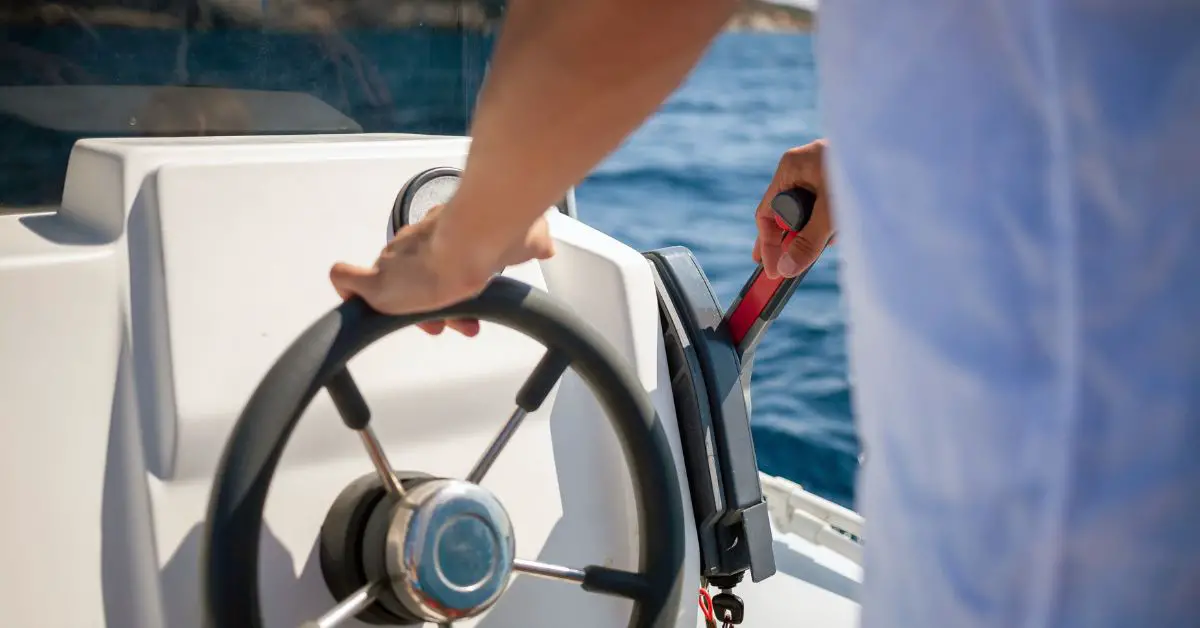Driving a boat can be an exhilarating and enjoyable experience, but it also requires knowledge and skill to ensure safety on the water. Whether you’re a seasoned boat owner or looking to get into recreational boating, understanding the basics of boat driving is essential.
Whether you’re a seasoned veteran or a beginner with a burning curiosity, mastering the essentials of boat driving is an imperative step in your nautical journey.
This article will serve as your compass, providing comprehensive, step-by-step instructions to steer your boat safely. Empower yourself with knowledge, sling on your captain’s hat, and prepare to navigate the waters with newfound confidence.
Essential Knowledge Before Driving a Boat
Before you embark on your boating adventure, you must know some important things. First, you should familiarize yourself with the different types of boats and their specific features.
Understanding the basics of steering control and throttle handling is crucial for operating a boat safely. Additionally, it’s essential to understand the water conditions, such as the water depth, flow, and potential hazards.
Equipping yourself with the necessary safety equipment, including life jackets and other safety gear, is a priority. Lastly, obtaining the required boating license or certification is crucial for legal and safety reasons.
Before you set out, you’ll need to run through your pre-departure checklist, which will help you ensure that you and your vessel are equipped with everything you may need for your voyage. You can enjoy a smooth and safe boating experience by being well-prepared and knowledgeable about these factors.
Driving Inboard vs Outboard Motors
Inboard Motors
To drive a boat with an inboard motor, you can follow these general steps:
1. Start the Engine: Before starting the engine, ensure all switches are in the “off” position. Slowly and steadily pull the starter cord until the engine engages and starts running smoothly.
2. Familiarize Yourself with the Controls: Get to know the throttle, shift lever, steering wheel, and any additional controls specific to your boat. Practice operating each control to become comfortable with them.
3. Steering: Use the steering wheel to turn the boat in the desired direction. Remember that inboard boats rely on rudders to help with steering.
4. Shifting Gears: Use the shift lever to engage forward or reverse gears. Be gentle when shifting gears to avoid sudden movements or damage to the engine.
5. Throttle Control: Adjust the throttle control to increase or decrease the boat’s speed. Gradually increase the throttle to move forward and decrease it to slow down or stop. Be mindful of the speed limits in your area and adjust accordingly.
6. Docking: When docking an inboard boat, approach the dock at an angle, reduce speed, and use reverse gear to swing the transom into the dock.
Outboard Motors
Driving a boat with an outboard motor follows similar principles but with a few differences. Here are some additional steps specific to outboard motors:
1. Start the Engine: Make sure the engine is neutral. Depending on the outboard motor, you may need to follow specific starting procedures outlined in the manufacturer’s manual. Gas-powered outboard motors must be treated cautiously, especially before you set out.
Dangerous fumes can build up in the engine compartment if the boat has been sitting. That’s why engines have blowers to help vent those fumes.
2. Steering: Outboard motors typically have a steering wheel or tiller handle. Use the steering mechanism to steer the boat in the desired direction. Unlike inboard boats, outboard motors do not rely on rudders for steering.
3. Trim Adjustment: Outboards have a trim feature that allows you to adjust the angle of the motor relative to the water. Trim up the motor when operating in shallow waters to prevent propeller damage.
4. Throttle Control: Similar to inboard boats, adjust the throttle control to control the boat’s speed. Gradually increase or decrease the throttle to reach the desired speed.
The Role of the Steering Wheel
The steering wheel plays a crucial role in driving a boat, as it determines the direction of travel on the water. It allows the boat owner to maneuver the boat in different conditions, such as calm, deep, and smooth water.
Adjusting the steering wheel is essential to navigate safely, especially when faced with changing water conditions or obstacles.
The steering wheel differs from a tiller, which is another method of controlling the direction of a boat. The advantage of using a steering wheel is that it provides a more comfortable and convenient way to navigate, especially on larger boats.
It allows for precise steering control and offers a better grip, making it easier to make subtle adjustments. However, steering wheels are generally found on modern boats with outboard or inboard motors.
On the other hand, tillers are mainly found on smaller boats or those with a single-engine setup. While tillers offer direct control and faster response, they may require more physical effort, especially in rough water conditions. Additionally, they may limit the available space on the boat, making it less comfortable for passengers.
Understanding the advantages and disadvantages of using a steering wheel versus a tiller can help boat owners decide which method suits their needs.
Throttle Handle Instructions
Used to control the speed and movement of the vessel, the throttle handle plays a crucial role in boat control. However, it’s important to note that using the throttle on a boat differs significantly from using the accelerator in a car.
Unlike a car, boats do not have brakes, so manual deceleration is necessary. To slow down, gradually push the throttle handle forward to decrease the boat’s speed. To accelerate, pull the handle backward, increasing the speed. It’s crucial to maintain situational awareness and make throttle adjustments as necessary.
When handling the throttle handle, it’s important to remember a few key points. First, be mindful of water conditions and adjust the throttle accordingly. For example, reducing speed in rough waters is advisable to maintain control. Additionally, when navigating through shallow waters or areas with obstacles, reducing speed is crucial to avoid damaging the boat or propellers.
How to Start a Boat
To start a boat, follow these general steps:
1. Pre-Start Checks: Before starting the boat engine, conduct a few essential checks:
- Ensure you are in an open area of water with sufficient depth.
- Make sure the boat’s fuel tank has enough fuel for your outing.
- Check that the battery is properly connected and has enough charge.
- Ensure all switches and controls are in the proper position.
2. Ignition Switch: Locate the ignition switch on the boat’s control panel. Insert the boat key into the ignition switch and turn it to the “On” or “Start” position. If your boat has a push-button start, press the start button instead.
3. Choke or Primer: Depending on the type of boat and engine, you may need to engage the choke or use the primer to provide additional fuel for the engine during startup. Consult your boat’s manual for specific instructions regarding the choke or primer.
4. Throttle Control: Set the throttle control to the “Neutral” position. This ensures the engine starts safely without engaging the propeller.
5. Start the Engine: With the ignition switch in the proper position and the throttle control in neutral, turn the key to the “Start” position. If your boat has a push-button start, press and hold the start button until the engine fires up. Release the key or button once the engine starts.
6. Engine Kill Switch: If the boat has a “kill switch” (also known as an engine safety cut-off, which automatically turns the engine off if you leave the helm for any reason), clip the lanyard on a belt loop of the life jacket ring. Then, if you move away from the helm, the lanyard yanks the clip out from under the knob, and the engine immediately stops.
7. Engine Warm-Up: Allow the engine to warm up for a few minutes before putting it into gear. This helps ensure proper engine lubrication and optimal performance.
8. Shift into Gear: Once the engine is warmed up and idling smoothly, move the throttle control into gear (Forward or Reverse) to start moving the boat. Adjust the throttle as needed to control the boat’s speed.
How to Steer a Boat
Driving a boat with a steering wheel is a convenient and comfortable way to navigate, whether your boat has an inboard or outboard motor. Factors like wind, waves, and the current can shove your boat this way and that, and when you turn a boat’s steering wheel, it won’t always necessarily react exactly as you had expected.
Here’s a step-by-step guide on how to drive with a steering wheel:
1. Get familiar with the steering wheel: Locate the steering wheel on your boat. It is typically found at the helm, near the driver’s seat.
2. Determine the direction of travel: To steer the boat in the desired direction, turn the steering wheel. Turning the wheel clockwise will make the boat turn to the right while turning it counterclockwise will make the boat turn to the left.
3. Control the speed: Use the throttle handle to control the boat’s speed. Pushing the handle forward will increase the speed while pulling it backward will decrease the speed. Gradually adjust the throttle to achieve the desired speed.
4. Practice trimming the boat: Trimming refers to adjusting the angle of the motor to optimize boat performance in different water conditions. Keep the motor in a neutral or slightly negative trim position in calm or smooth water. Trim the motor up to a 20-degree angle in rough or choppy water for better control and stability.
5. Entering the Marina: When entering the marina, slowly approach the dock using a combination of forward gear and neutral, shifting in and out of gear to maintain minimal headway.
How to Trim a Boat
Trimming a boat is essential for any boat owner to ensure optimal performance and safety on the water. It involves adjusting the running attitude of the boat, which can be bow down, bow level, or bow up. Trimming consists of manipulating the outdrive’s angle or deploying “trim tabs” (small plates on the stern of the boat).
Understanding how to trim a boat properly can dramatically affect how comfortable the ride is, but every boat reacts differently to trimming in different sea conditions.
To trim a boat, you can utilize trimmable drives or trim tabs. Trimmable drives allow you to adjust the trim of the boat’s motors, while trim tabs are adjustable surfaces on the hull that influence the boat’s running attitude.
Achieving the proper trim setting is influenced by several factors, including weight distribution and sea conditions. Generally, a bow-down trim is ideal for rough water conditions, as it helps the boat cut through waves. Conversely, a bow-up trim is better suited for calm waters, as it reduces hull drag and improves speed.
Regularly adjusting the trim and monitoring the boat’s performance is crucial. Improper trim can affect fuel efficiency, handling, and even safety. Experiment with different trim settings to find what works best for your boat and the specific water conditions.
By mastering the art of trimming, boat owners can enhance their overall performance and enjoy a smoother ride on the water. So, take the time to understand and practice trimming your boat and make the necessary adjustments to optimize your boating experience.
How to Slow a Boat
Slowing a boat down safely and effectively requires proper technique and awareness. Start by pulling the throttle back to neutral to slow the boat. This will disengage the forward gear and slow the boat down. It’s crucial to pause momentarily in the neutral position before shifting into reverse.
Therefore, slowing down requires more than just taking your foot off the pedal; you must grasp the throttle and pull it back. This is important because you must be prepared to move the throttle accordingly when you see a large wave or lots of incoming traffic.
Pausing in neutral is important as it allows the propeller to stop spinning before shifting into reverse. Failing to pause can cause mechanical damage and strain the boat’s transmission. After pausing in neutral, shift into reverse and apply some power to engage the reverse gear.
Following this process, you can slow down your boat smoothly and avoid any damage to the engine or transmission. Practicing this technique in a safe and open area is important to understand how your boat responds.
How to Dock a Boat
Docking a boat can be challenging for new boaters, but it can be done easily with proper techniques and practice. Docking a boat is one of the boating basics; to do it properly, you must be able to balance well. Here are some steps on how to dock a boat:
1. Approach the dock slowly: Approach the dock slowly, controlling the speed with the throttle and maintaining the direction with the steering.
2. Determine the wind and current: Check the wind and current direction and strength. You may need to make adjustments based on those factors.
3. Position the boat parallel to the dock: Position the boat at a distance next to the dock, parallel to it.
4. Use the reverse gear: Shift the boat into reverse and use it as needed to control its movement and speed while maneuvering.
5. Use the dock lines: Have at least two lines ready to secure the boat to the dock as soon as you’re close enough. Secure the bow and stern first.
6. Check the position of the boat: Make sure the boat is aligned properly with the dock and secured by checking from different angles.
Conclusion
Mastering the art of driving a boat requires knowledge, skills, and responsible behavior. There are dozens of different types of boats, and they will all drive and handle differently on the water. Following the best practices outlined in this article can ensure a safe and enjoyable boating experience for yourself and your passengers.
Remember to familiarize yourself with the boat’s controls and instruments, maintain a proper lookout, and navigate cautiously. Stay alert, obey maritime regulations, and respect the environment. Always be prepared for unexpected situations, such as adverse weather or emergencies.
Driving a boat is not just about steering and controlling the vessel; it’s about being a responsible captain. By practicing good seamanship and understanding the importance of safety measures, you can avoid accidents and protect everyone on board.
Becoming a skilled boat driver takes practice and experience, like learning to drive a car. So, get out on the water, gain confidence in your abilities, and continue to improve your boating skills.
Remember that all boats are different, and learning how to drive any boat takes some practice. Enjoy the freedom, tranquility, and exhilaration of boating, and have an unforgettable time exploring the vast oceans, rivers, and lakes.








